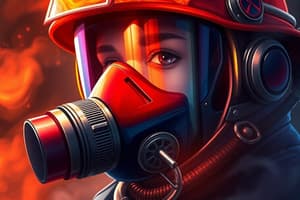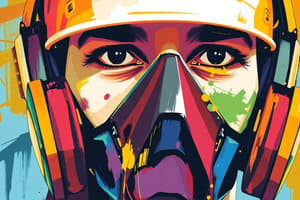Podcast
Questions and Answers
Which of the following best describes personal protective equipment (PPE)?
Which of the following best describes personal protective equipment (PPE)?
- Equipment used to minimize exposure to workplace hazards (correct)
- Equipment used to maximize exposure to workplace hazards
- Equipment used to enhance workplace productivity
- Equipment used to cause workplace injuries and illnesses
What are the potential sources of hazards that PPE can protect against?
What are the potential sources of hazards that PPE can protect against?
- Chemical, biological, radiological, physical, social
- Chemical, biological, radiological, emotional, mechanical
- Chemical, biological, radiological, physical, mental
- Chemical, biological, radiological, physical, mechanical (correct)
What are some potential health effects that respiratory protection can help prevent?
What are some potential health effects that respiratory protection can help prevent?
- Eye strain
- Muscle soreness
- Cancer and lung impairment (correct)
- Skin irritation
What is the main purpose of wearing PPE?
What is the main purpose of wearing PPE?
What are some potential hazards that respiratory protection can protect against?
What are some potential hazards that respiratory protection can protect against?
Flashcards are hidden until you start studying
Study Notes
Personal Protective Equipment (PPE)
- PPE refers to wearable devices or equipment designed to protect users from occupational hazards
Sources of Hazards Protected Against by PPE
- Chemical hazards (e.g., hazardous substances, pesticides, and chemicals)
- Physical hazards (e.g., falling objects, heat, cold, and noise)
- Biological hazards (e.g., viruses, bacteria, and other microorganisms)
- Radiological hazards (e.g., radiation)
Health Effects Prevented by Respiratory Protection
- Respiratory diseases (e.g., asthma, chronic obstructive pulmonary disease (COPD))
- Lung damage and scarring
- Cancer
- Other respiratory problems
Main Purpose of Wearing PPE
- To reduce the risk of injury or illness from occupational hazards
Hazards Protected Against by Respiratory Protection
- Airborne contaminants (e.g., dust, mist, vapor, gas, and fume)
- Oxygen-deficient atmospheres
- Toxic substances (e.g., chemicals, heavy metals)
Studying That Suits You
Use AI to generate personalized quizzes and flashcards to suit your learning preferences.




